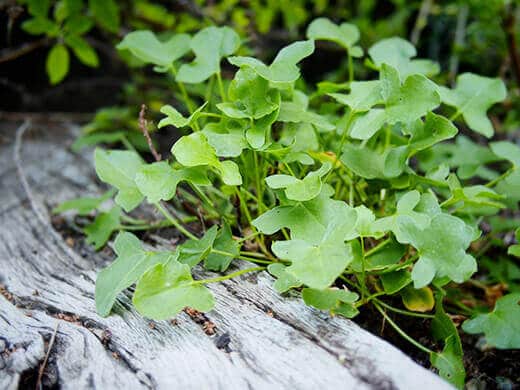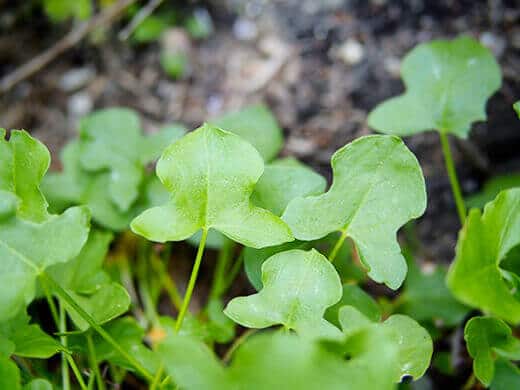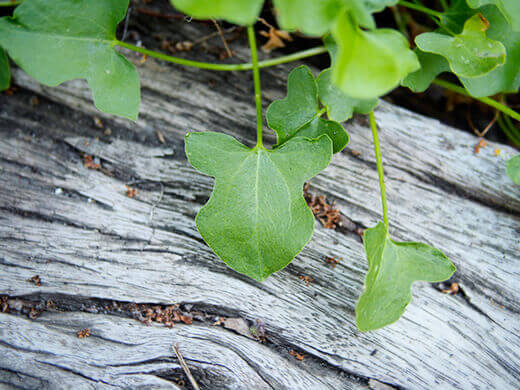True French sorrel (Rumex scutatus) is one of those things in my garden that’s very underused, but when I do use it, I wonder why I don’t do it more often.

The leafy herb is not to be confused with what’s sometimes called French sorrel, but is really common sorrel or garden sorrel (Rumex acetosa). There is only one French sorrel — True French sorrel, that is — with leaves that are small and shaped like a shield (scutatus is Latin for “armed with a shield”).

Or, shaped like a teddy bear the other way around.

The whole plant grows low to the ground (almost like a creeping vine, but non-invasive) no taller than 6 to 12 inches. You can divide the clump every couple of years and it will re-grow with vigor. As a cold-hardy perennial herb, it stays green and vibrant almost all winter.

It’s also one of the most low-maintenance plants in my herb garden, resistant to pests and nearly indestructible, as evidenced by the plant bouncing back after being nearly chomped to the ground by my chickens. It’s tolerant of my forgetfulness to water on a consistent basis.
On a hot summer day, it’s still bright-eyed and bushy-tailed and I’ve never seen a droopy leaf, even hours after I’ve harvested the herb and left it on the counter. For that reason alone, it’s an excellent addition to salads and sandwiches that you want to take to work.
True French sorrel has a tangy lemon flavor — like a milder version of lemon verbena, or as I love to describe it, sour green grapes.
Its tartness comes from oxalic acid, the same chemical that makes rhubarb so sour (in fact, they both belong to Polygonaceae, the buckwheat family). This same chemical is present in other sour dock species (like Rumex sanguineus, also known as bloody dock or red-veined sorrel) and wood sorrel species (like Oxalis triangularis, known as purple shamrock).
(As an aside, the name “True French sorrel” can sometimes be confusing because it’s unrelated to the wood sorrel family, which is Oxalidaceae.)
It’s very high in vitamin C (known to treat scurvy way back when sailors in the 16th to 18th centuries were afflicted with such diseases) and rich in iron and potassium.
I like to toss whole leaves into a salad for a burst of flavor, but you can use it as you would any other herb — minced and mixed into a marinade or dressing, chopped and sauteed into a creamy buttery sauce, or stuffed into chicken breasts or flank steaks. If you have a recipe that calls for lemon zest, try True French sorrel instead.
Recently I’ve been using the herb in what I call the “garden on toast”… a quick and easy breakfast made with that morning’s harvest. All you need are a bagel and a schmear, a few leaves of True French sorrel, and a handful of fresh veggies sliced or diced to your liking.

Your Garden on Toast
Makes as many servings as you want
Ingredients
English muffin or bagel
Cream cheese
A few leaves of True French sorrel
Thinly sliced cucumbers
Thinly sliced carrots
Thinly sliced red bell peppers
Fresh cracked black pepper
And whatever else you want (sometimes I’ll add a fried egg or smoked salmon)
Making Your Garden On Toast
This is what I call a freestyle recipe. You can go wild with it and use whatever’s in season in your garden or still lingering in your crisper drawer.
First, toast up your English muffin or bagel. Slather on some cream cheese. Layer your True French sorrel, veggies and other goodies on top, and finish with a few turns of cracked black pepper. Eat it open-faced or make it a muffin-wich (bagel-wich?) for breakfast on the go!

Your Garden On Toast

All you need are a bagel and a schmear, a few leaves of True French sorrel, and a handful of fresh veggies sliced or diced to your liking.
Ingredients
- English muffin or bagel
- Cream cheese
- A few leaves of True French sorrel
- Thinly sliced cucumbers
- Thinly sliced carrots
- Thinly sliced red bell peppers
- Fresh cracked black pepper
- And whatever else you want (sometimes I'll add a fried egg or smoked salmon)
Instructions
- First, toast up your English muffin or bagel.
- Slather on some cream cheese.
- Layer your True French sorrel, veggies and other goodies on top, and finish with a few turns of cracked black pepper.
- Eat it open-faced or make it a muffin-wich (bagel-wich?) for breakfast on the go!
Recommended Products
As an Amazon Associate and member of other affiliate programs, I earn from qualifying purchases.


















What causes small ring shaped spots French sorrel. Can you still eat them wilted?
I’m not sure, as it could be a disease like leaf spot, or it could be pest damage. As for eating the leaves while they’re wilted, sure you can, as long as the leaves aren’t damaged as you say. To revive leafy greens, you can soak them in a bowl of very cold to icy water for about 30 minutes. They’ll crisp right up again.
Where can you buy these seeds online? I keep seeing giant French sorrel online.
I started my true French sorrel from a seedling purchased from http://www.richters.com.
Love it ! Garden on toast is a daily ritual for me. In the winter, greens and pickled goodies. Great blog.
Herb that tastes like milder lemon verbena. True French Sorrel (and Your Garden on Toast) http://t.co/cDgXLoDlX0 < TY for RT! @Angry_Saguaro
A burst of lemony flavor in every leaf! True French Sorrel (and Your Garden on Toast) http://t.co/Kc8SVdLcjT #gardenchat #gardening
Resistant to pests and nearly indestructible in the garden: True French Sorrel (and Your Garden on Toast) http://t.co/MTorik3x61 #gardenchat
RT @theGardenBetty: A perennial herb that tastes like a milder lemon verbena. True French Sorrel (and Your Garden on Toast) http://t.co/cDg…
A perennial herb that tastes like a milder lemon verbena. True French Sorrel (and Your Garden on Toast) http://t.co/cDgXLoDlX0 #gardenchat
A low-maintenance and lemony herb that grows year-round. True French Sorrel (and Your Garden on Toast) http://t.co/8hbGUTR3TB #gardenchat
A tangy herb that tastes like sour green grapes. True French Sorrel (and Your Garden on Toast) http://t.co/VXBTLmWITi #gardenchat #gardening
Kitchen Garden Maui liked this on Facebook.
True French Sorrel (and Your Garden on Toast):
True French sorrel (Rumex scutatus) is one of those things in … http://t.co/Qj7hp9BsOn
Blogged on Garden Betty: True French Sorrel (and Your Garden on Toast) http://t.co/M8un396KKf